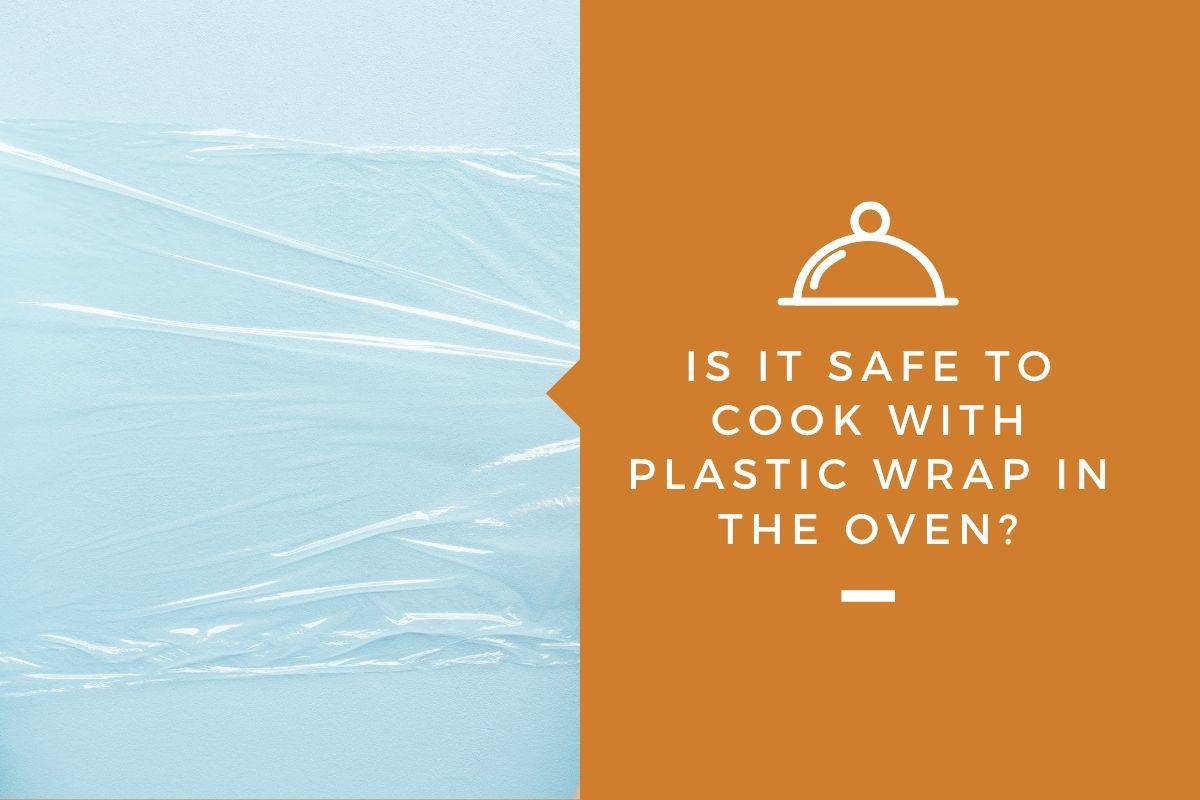Plastic wrap, cling film, saran wrap, or food wrap are all different ways of describing the same popular item that’s used frequently in the kitchen to either wrap food or cover bowls to keep food fresh. Both aluminum foil and parchment paper can do some of the things that plastic wrap does, but they’re not the same.
It’s fine to use all of them to wrap food but when there’s heat involved it’s important to be careful. They’re not equally resistant to heat. You may have considered placing plastic wrap in the oven.
Up until recently, I was a firm believer that no one used plastic wrap in the oven but as it turns out, there are acknowledged chefs who do it on a regular basis.
But should it be done? What are the consequences? Whenever heat is added to the equation you have to reconsider the consequences, regardless of the material used.
Plastic wrap shouldn’t be used in the oven as it will melt and, potentially, leach toxins when heated. Today most plastic wrap is free from phthalate, which could be linked to many health problems. Diethylhexyl adipate was introduced to replace phthalate, and that too can be linked to health problems, primarily breast cancer. Most manufacturers state that their plastic wraps aren’t oven-safe. But there is oven-safe plastic wrap that can be used in the oven if it’s double-layered with aluminum foil.
The last part, about plastic wrap actually being safe to use if executed correctly, was something that I came in contact with then I was experimenting with a recipe that required me to place plastic wrap in the oven.
My trust in that chef fell as soon as I read “Wrap the dish in plastic wrap….” but I started researching the topic and found out more.
What Plastic Wrap is Oven Safe?
But what type of plastic wrap is actually save to place in the oven? All of them? No, I would absolutely opt for a plastic wrap that contains as little of the bad stuff as possible. Chemical-free plastic wrap that’s capable of withstanding a bit of heat.
Plastic wrap comes in a wide variety of different brands for different purposes, ranging from industrial plastic wrap to food-grade plastic wrap. Choosing a high-quality plastic wrap that’s considered oven-safe is the first and most important step.
With a high-quality plastic wrap in hand, you’re one step closer to cooking with plastic wrap. I’ve been using Stretch-Tile’s plastic wrap for all of my oven endeavors that include plastic. It’s a high-quality, bpa-free plastic wrap that’s labeled as both microwave and oven-safe.
This means that the product has been tested using FDA-approved tests to see if the product is indeed safe to use in the microwave, or oven, or not. This doesn’t mean that the product can withstand any temperature without melting.
Instead, it’s more of an indication that the plastic doesn’t release toxins at the same rate that other plastic does.
The second thing you need is aluminum foil. Yes, you’re going to need both of them as we’re going to do something called double-layering. That’s what keeps the plastic wrap from melting.
According to chemistry professor Robert L Wolke, who was questioned on the subject by a journalist from The Washington Post, this double-layering technique prevents the plastic wrap from reaching temperatures above 212 degrees Fahrenheit, which also prevents it from melting.
He also states that most home-use plastic wrap won’t melt until it reaches 220-250 degrees Fahrenheit. Basically, this tells us that the temperature inside the oven is less relevant as long as the plastic wrap is covered in aluminum foil, which somehow prevents it from melting. How though?
Here’s a quote from The Washington Post, which explains the process in detail:
“The aluminum foil shields the roast from the convection of hot air in the oven and also from infrared radiation. But the foil is so thin and insubstantial that it cannot absorb and retain enough heat to get very hot; you could remove it with your bare hands, even from a 350-degree oven. It doesn’t even get hot enough to melt the plastic film beneath it.
“Meanwhile, the plastic film is preventing the escape of water vapor (steam) from the turkey, thus keeping it moist. As the turkey cooks, the wet plastic film itself cannot get any hotter than 212 degrees, the temperature at which its ‘wetness’ boils away.”
The Washington Post
With all of this said, I wouldn’t recommend placing plastic wrap in the oven without caution. There are certainly risks involved and the only exception that I’ve found is the double-layering method.
Other than that, I don’t think I’ve seen people recommend using plastic wrap in the oven, which sounds smart enough.
Will Plastic Wrap Melt in the Oven?

Now that we’ve started considering using plastic wrap in the oven, a question that becomes more relevant is whether or not the plastic wrap will melt in the oven. Generally speaking, plastic doesn’t handle high heat very well and even less so when it’s thinner than a plastic bag.
The truth is that plastic wrap will melt in the oven, no doubt. As mentioned above, most home-use plastic wrap melts at 225-250 degrees Fahrenheit, and few meals are cooked at or under those temperatures in the oven.
In fact, plastic wrap will melt in most scenarios where it’s combined with heat, and should therefore be used for less heated tasks.
The exception here is the aluminum foil, which prevents the plastic wrap from reaching its melting point. Without the aluminum foil, the plastic wrap will melt in no time.
Is Plastic Wrap Flammable?
Earlier in the article, we established that the melting point of home-use plastic wrap is set somewhere around 225-250 degrees Fahrenheit. When your plastic wrap has started melting, it’s not entirely preposterous to assume that it may also start burning.
As the plastic melts, it shrinks and merges with the surface that it’s placed upon. Making it remarkably difficult to remove from said surface. This process also releases hazardous gasses, but does it lead to a fire?
It could, potentially, cause the plastic wrap to catch on fire. In many cases, however, it will simply melt the plastic wrap and keep shrinking it or cause “blobbing” on the plastic. But because the risk of starting a fire isn’t out of the question entirely, it’s just as important to avoid exposing plastic wrap to temperatures above its melting point.
Is Melted Plastic Wrap Toxic?
Yes, without a doubt. You do not want to expose yourself or others to the gasses that melting plastic releases, they’re associated with health problems, ranging from mild to severe.
What Temperature Can Plastic Wrap Withstand?
Somewhere between 225-250 degrees Fahrenheit. Surpassing these numbers will undoubtedly cause the plastic wrap to melt. This is by no means a universal answer for all plastic wrap products and, therefore, I recommend that you look on the product label to get a more specific answer regarding temperature.
Will Plastic Wrap Also Melt in the Microwave?
Plastic wrap can absolutely melt in a microwave oven too. This usually happens when steaming hot food comes in contact with the plastic wrap that’s used to cover it. The heat will migrate from the food over to the plastic wrap, which will reach temperatures above its melting point.
Using a plastic wrap that’s labeled as microwave-safe and making sure that it doesn’t come in direct contact with food should be enough to prevent it from melting. In order to get a microwave-safe label on their product, the manufacturers have to test their product using tests that meet FDA standards for a bunch of different parameters.

